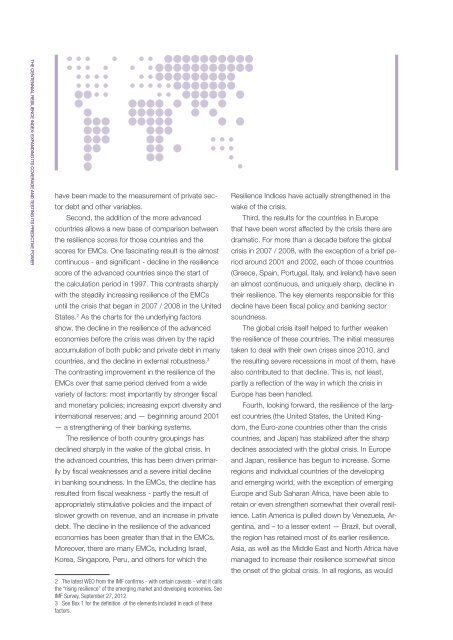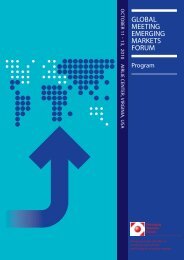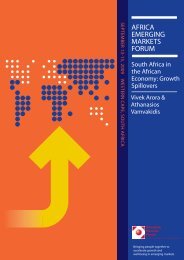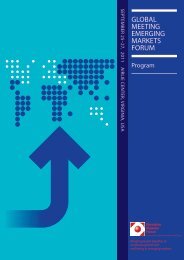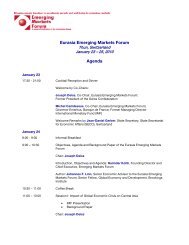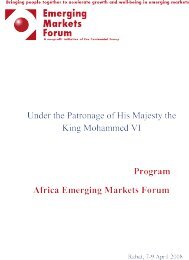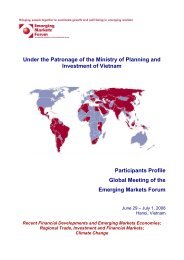The Centennial Resilience Index: Expanding Its Coverage and ...
The Centennial Resilience Index: Expanding Its Coverage and ...
The Centennial Resilience Index: Expanding Its Coverage and ...
Create successful ePaper yourself
Turn your PDF publications into a flip-book with our unique Google optimized e-Paper software.
THE CENTENNIAL RESILIENCE INDEX: EXPANDING ITS COVERAGE AND TESTING ITS PREDICTIVE POWERhave been made to the measurement of private sectordebt <strong>and</strong> other variables.Second, the addition of the more advancedcountries allows a new base of comparison betweenthe resilience scores for those countries <strong>and</strong> thescores for EMCs. One fascinating result is the almostcontinuous - <strong>and</strong> significant - decline in the resiliencescore of the advanced countries since the start ofthe calculation period in 1997. This contrasts sharplywith the steadily increasing resilience of the EMCsuntil the crisis that began in 2007 / 2008 in the UnitedStates. 2 As the charts for the underlying factorsshow, the decline in the resilience of the advancedeconomies before the crisis was driven by the rapidaccumulation of both public <strong>and</strong> private debt in manycountries, <strong>and</strong> the decline in external robustness. 3<strong>The</strong> contrasting improvement in the resilience of theEMCs over that same period derived from a widevariety of factors: most importantly by stronger fiscal<strong>and</strong> monetary policies; increasing export diversity <strong>and</strong>international reserves; <strong>and</strong> — beginning around 2001— a strengthening of their banking systems.<strong>The</strong> resilience of both country groupings hasdeclined sharply in the wake of the global crisis. Inthe advanced countries, this has been driven primarilyby fiscal weaknesses <strong>and</strong> a severe initial declinein banking soundness. In the EMCs, the decline hasresulted from fiscal weakness - partly the result ofappropriately stimulative policies <strong>and</strong> the impact ofslower growth on revenue, <strong>and</strong> an increase in privatedebt. <strong>The</strong> decline in the resilience of the advancedeconomies has been greater than that in the EMCs.Moreover, there are many EMCs, including Israel,Korea, Singapore, Peru, <strong>and</strong> others for which the2 <strong>The</strong> latest WEO from the IMF confirms - with certain caveats - what it callsthe “rising resilience” of the emerging market <strong>and</strong> developing economies. SeeIMF Survey, September 27, 2012.3 See Box 1 for the definition of the elements included in each of thesefactors.<strong>Resilience</strong> Indices have actually strengthened in thewake of the crisis.Third, the results for the countries in Europethat have been worst affected by the crisis there aredramatic. For more than a decade before the globalcrisis in 2007 / 2008, with the exception of a brief periodaround 2001 <strong>and</strong> 2002, each of those countries(Greece, Spain, Portugal, Italy, <strong>and</strong> Irel<strong>and</strong>) have seenan almost continuous, <strong>and</strong> uniquely sharp, decline intheir resilience. <strong>The</strong> key elements responsible for thisdecline have been fiscal policy <strong>and</strong> banking sectorsoundness.<strong>The</strong> global crisis itself helped to further weakenthe resilience of these countries. <strong>The</strong> initial measurestaken to deal with their own crises since 2010, <strong>and</strong>the resulting severe recessions in most of them, havealso contributed to that decline. This is, not least,partly a reflection of the way in which the crisis inEurope has been h<strong>and</strong>led.Fourth, looking forward, the resilience of the largestcountries (the United States, the United Kingdom,the Euro-zone countries other than the crisiscountries, <strong>and</strong> Japan) has stabilized after the sharpdeclines associated with the global crisis. In Europe<strong>and</strong> Japan, resilience has begun to increase. Someregions <strong>and</strong> individual countries of the developing<strong>and</strong> emerging world, with the exception of emergingEurope <strong>and</strong> Sub Saharan Africa, have been able toretain or even strengthen somewhat their overall resilience.Latin America is pulled down by Venezuela, Argentina,<strong>and</strong> – to a lesser extent — Brazil, but overall,the region has retained most of its earlier resilience.Asia, as well as the Middle East <strong>and</strong> North Africa havemanaged to increase their resilience somewhat sincethe onset of the global crisis. In all regions, as would


